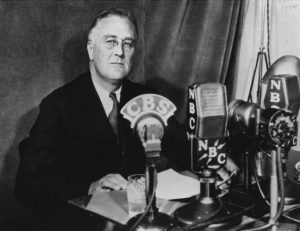
President Franklin Roosevelt, who called his agenda the “Fair Deal”
This week, Democratic Party leaders finally revealed their positive unifying agenda for America. On Sunday, House Minority Leader Nancy Pelosi, the second highest-ranking elected Democrat, published an op-ed in the Washington Post. Yesterday, Senate Minority Leader Chuck Schumer, the highest-ranking elected Democrat, published his op-ed in the New York Times. The Democrats are calling their plan “A Better Deal.” According to Schumer’s op-ed:
Democrats will show the country that we’re the party on the side of working people — and that we stand for three simple things. First, we’re going to increase people’s pay. Second, we’re going to reduce their everyday expenses. And third, we’re going to provide workers with the tools they need for the 21st-century economy.
More specifically, Schumer pointed to items the Democrats have proposed, and to proposals they will make in the future, including:
- A $1 trillion infrastructure plan to repair our crumbling roads and bridges, which will create many jobs, especially in construction;
- Increasing the federal minimum wage to $15 per hour;
- Providing paid family and sick leave;
- Rules to stop prescription drug price gouging;
- Tougher antitrust laws to block mergers that result in higher prices for things like cable television, airline tickets and food;
- Tax credits for employers to train workers for vacant jobs;
- Rebuilding rural America and changing trade laws to benefit workers.
First the good news: this is a moment many of us having been waiting for. It’s the very reason Messaging Matters was started. It’s the very thing that Democrats sorely lack in off-year elections, when there is no presidential candidate around which to rally, and each party must instead articulate its vision in a dynamic way. Plenty of folks have complained that, while the Democrats are good at expressing their values through legislation, too often it sounds like their message is “look how bad those Republicans are,” which does not tend to inspire voters.
Furthermore, “A Better Deal” follows successful Democratic Party themes from the past, including Franklin Roosevelt‘s “New Deal” in 1932 and Harry Truman‘s “Fair Deal” in 1949. “A Better Deal” might also be a tweak at Donald Trump, who first became famous in part due to his 1987 book “The Art of the Deal” and who seems to love the word “deal.”
Whether “A Better Deal” will resonate with American voters remains to be seen. One potential issue is that the slogan is not visceral. It appeals more to the head than the heart, which has been the Democrats’ problem for a long time. Moreover, the use of “Better” is still a direct comparison to the Republicans. That’s why something like our idea of “We Have Your Back” would have been preferable. Additionally, given the Republicans’ majority in all three branches of government, the Democrats cannot currently do much more than articulate their principles in the hope that more voters will side with them in upcoming elections, such as the election for the House of Representatives in 2018.
Nevertheless, the Democratic Party finally has put forth a positive set of principles around which to rally, and should be commended for doing so.
Photo by FDR Presidential Library & Museum, used under Creative Commons license. https://is.gd/I5PVvJ


